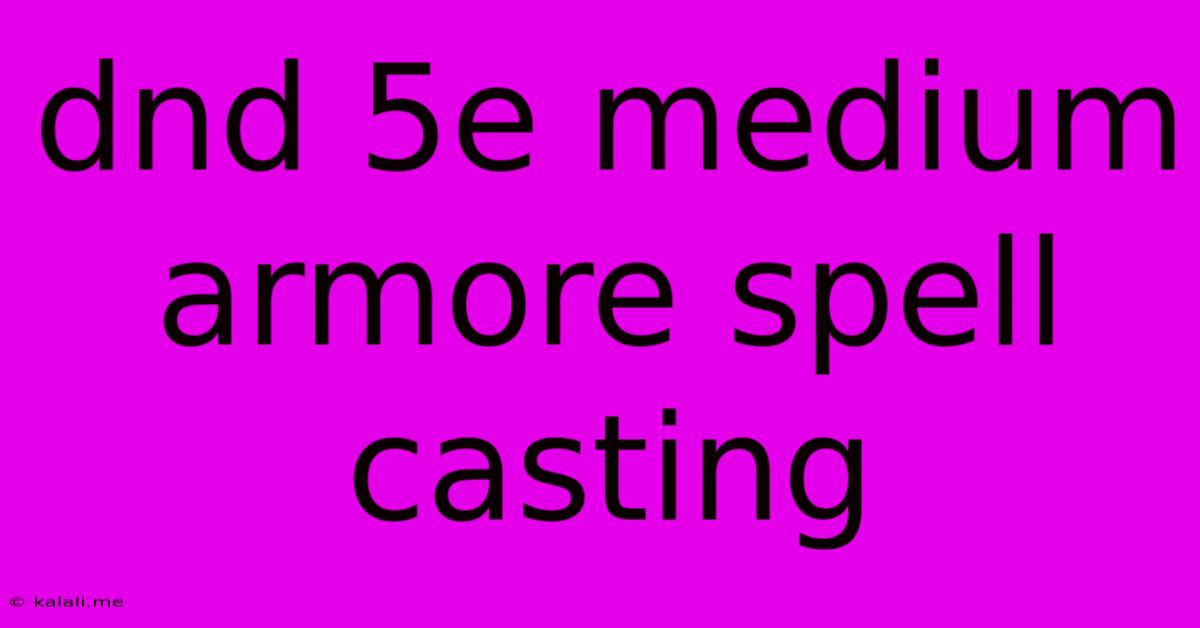Dnd 5e Medium Armore Spell Casting
Kalali
May 23, 2025 · 3 min read

Table of Contents
D&D 5e Medium Armor Spellcasting: A Comprehensive Guide
Meta Description: Learn everything about spellcasting in medium armor in D&D 5e. This guide covers the rules, benefits, drawbacks, and optimal character builds for spellcasters who prefer the protection of medium armor. We'll explore the best classes and subclasses for this playstyle.
Medium armor, offering a balance between protection and mobility, presents a compelling option for spellcasting characters in Dungeons & Dragons 5th Edition. However, it's not without its complexities. This guide delves into the intricacies of spellcasting while wearing medium armor, examining the rules, advantages, disadvantages, and optimal class choices to make the most of this versatile approach.
Understanding the Rules: Armor and Spellcasting
The core mechanic affecting spellcasting in armor lies in the Armor Proficiency feature possessed by some classes. Classes like the Paladin, Fighter, and Ranger gain proficiency with medium armor, allowing them to wear it without penalty to their spellcasting ability. Other classes, such as Clerics, Sorcerers, Warlocks, and Wizards, are typically unproficient with armor and face potential drawbacks.
Unarmored Spellcasters: Without armor proficiency, wearing armor imposes disadvantage on your attack rolls and ability checks that use Dexterity. Crucially, this does not affect spell attack rolls. However, the armor's weight could potentially influence your movement speed.
Proficient Spellcasters: For classes proficient in medium armor, wearing it doesn't negatively impact spellcasting. They can enjoy the defensive benefits of medium armor without sacrificing their spellcasting effectiveness.
The Advantages of Medium Armor Spellcasting
- Increased survivability: Medium armor provides a significant boost to AC compared to light armor or no armor at all. This translates to more chances to survive attacks from enemies, keeping you in the fight longer and allowing you to cast more spells.
- Tactical flexibility: The increased AC allows you to take on more aggressive roles, potentially moving closer to the frontline without being instantly incapacitated.
- Versatility: Medium armor offers a good balance between protection and mobility. You aren't hindered as severely as you might be wearing heavy armor, allowing you to react quickly to changing combat scenarios.
- Certain subclass synergy: Some subclasses benefit particularly from this playstyle. For instance, a Paladin's Divine Smite is much more effective when they can survive longer in combat.
The Disadvantages of Medium Armor Spellcasting
- Dexterity Dependence: While medium armor doesn't hinder spell attack rolls, many spells still rely on Dexterity saving throws. Lowering your Dexterity to accommodate heavier armor could negatively impact these throws. Carefully consider your Dexterity score and armor selection.
- Potential for encumbrance: Depending on your strength score and the weight of the armor and other equipment, you might find yourself encumbered, reducing your speed and potentially hindering spellcasting.
- Armor Choice Limitations: You're limited to medium armor types; some situations might call for the heavier protection of heavy armor, or the stealth benefits of light armor – neither of which you have access to.
Optimal Classes and Subclasses for Medium Armor Spellcasters
Several classes and subclasses excel as medium armor spellcasters:
- Paladin: Paladins are naturally suited for this role, combining spellcasting with powerful melee abilities. Their Divine Smite and other features synergize well with medium armor.
- Ranger: Rangers, particularly those focused on spellcasting, can benefit from the extra protection of medium armor. Their Hunter and Beast Master subclasses can be incredibly effective.
- Cleric (some domains): Certain Cleric domains, such as the War domain, can leverage medium armor effectively, though others might prefer light armor for higher Dexterity.
Building Your Medium Armor Spellcaster
- Prioritize Dexterity and Constitution: Dexterity boosts your AC and spell attack rolls, while Constitution increases your hit points and saves.
- Strength is secondary: While strength is important for carrying capacity, it's less crucial than Dexterity and Constitution for a spellcaster.
- Consider your spells: Choose spells that either don't require high Dexterity saving throws or use your strengths, such as your high AC, to maximize effectiveness.
By carefully considering the rules, advantages, disadvantages, and best-suited classes, you can create a powerful and versatile medium armor spellcaster that thrives in combat and beyond. Remember to customize your build based on your preferred playstyle and campaign setting!
Latest Posts
Latest Posts
-
Dnd 3 5e Feats That Give Casting
May 23, 2025
-
How To Remove A Screw With A Stripped Head
May 23, 2025
-
Ask Not For Whom The Bell Tolls
May 23, 2025
-
Joker Tarot Planet And Spectral Cards May Appear Multiple Times
May 23, 2025
-
She Turned Me Into A Newt
May 23, 2025
Related Post
Thank you for visiting our website which covers about Dnd 5e Medium Armore Spell Casting . We hope the information provided has been useful to you. Feel free to contact us if you have any questions or need further assistance. See you next time and don't miss to bookmark.